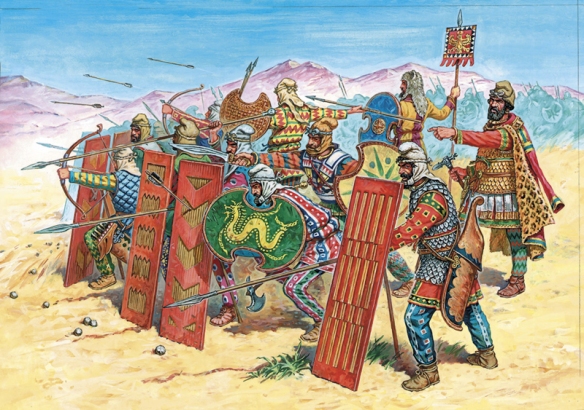Persian infantry were of the light and heavy varieties. Light infantry were armed with the bow and sling, weapons that made them excellent at harassment and mobility but weak in killing power. The fact that light infantry carried no short-range weapons or protections made it impossible for them to close with the enemy with any lethal effect. Cyrus corrected this deficiency by requiring the infantry to carry spears and swords and training the soldiers in close-order battle. Heavy infantry carried the long spear, short sword, and battle-axe, weapons designed for maximum lethality at close range. The heavy infantry wore black hoods over their heads and faces when engaged in close combat. When arrayed for battle, the front rank of the phalanx carried a tall wicker shield and a single spear, while the ranks behind them carried two spears and no shields, presumably one for throwing before contact and the other for close-order fighting. Elite Persian infantry was trained to advance in mass and in silence, a rather striking departure from the normal practice of yelling to strike terror in the hearts of the enemy.
The Persian chariot corps was small compared to those employed by Egypt and Assyria and under Cyrus reached a peak strength of only 300 machines. Initially, the Persians attempted to improve the chariot by making it heavier and higher with a larger platform. They also thickened the wheels, used heavier axles, and increased the number of wheel spokes. The result was that four horses were required to pull the vehicle. Since the chariot required a driver and mounted only a single archer or spearman, it required considerable man- and animal power for very little fi repower in return. The Persian use of the simple bow further reduced the lethality of the chariot-borne archer, and the weight of the machine made transport and movement over rough terrain difficult.
Cyrus tried to increase the lethality and shock power of the chariots by introducing the scythed chariot. Metal scythes attached to each of the chariot’s main axles extended outward two yards in length away from the sides of the machine. The idea was to drive the chariots through massed infantry and cavalry formations, letting the scythes do the work of killing as they went. While these chariots worked well enough against light infantry or undisciplined tribal armies, they were useless against a disciplined infantry or cavalry unit. As long as the infantry phalanx held its ground in packed formation, the horses would not charge through the wall of spears and shields.
The Persians introduced the use of wheeled mobile siege towers constructed of wood. These towers were three stories high (about twenty-four feet) and were pulled along by sixteen oxen linked by four shafts. Xenophon recorded that the weight of a tower was 13,920 pounds, or seven tons, when fully manned with men and equipment. Each story of the tower was manned with twenty archers, who, because of their vantage point above the battlefield, could rain down a hail of arrows on the enemy. The battle commander could also use the tower as a command and control center, its height providing him with an excellent view of the entire battlefield.
The Persian army used special squads of naphtha throwers in its siege tactics. Like “Greek fire,” we are unsure as to exactly what naphtha was or where it came from; it was similar in nature to oil, but of a thinner consistency, and it burned hot, thus allowing the Persian army to ignite structures during a siege. Cotton soaked in naphtha was attached to arrows and fi red against wooden fortifications. The most famous use of this technique was against the Greeks when Xerxes used it to burn the wooden walls of Athens and the roof of the Acropolis. Persian engineers were excellent and, like the combat engineers of today, often traveled ahead of the main body of the army, preparing roads, building bridges, digging ditches, and constructing marine jetties for use by the navy. Like the Assyrians before them, Persian engineers mastered the technique of using inflated animal skins and pontoon boats as floats for bridges. The Persians became expert at constructing bridges with covered sides and tops to prevent their horses from looking over the sides and bolting in fear. In the Babylonian War, military engineers diverted the course of the river running through the city to allow a Persian infantry force to gain entrance to the city by moving along the dry riverbed.
